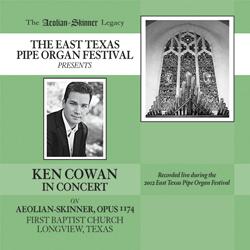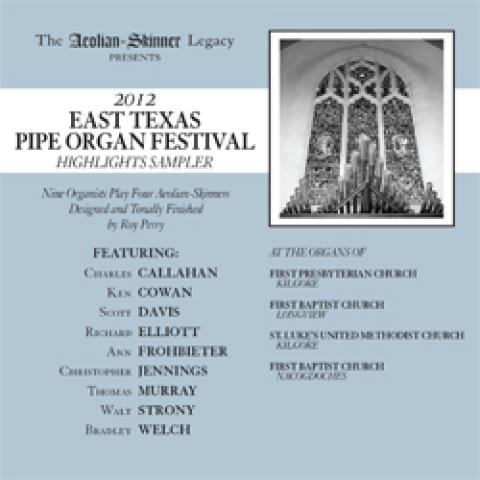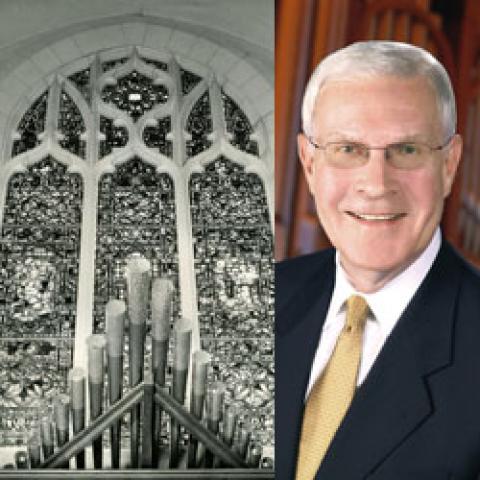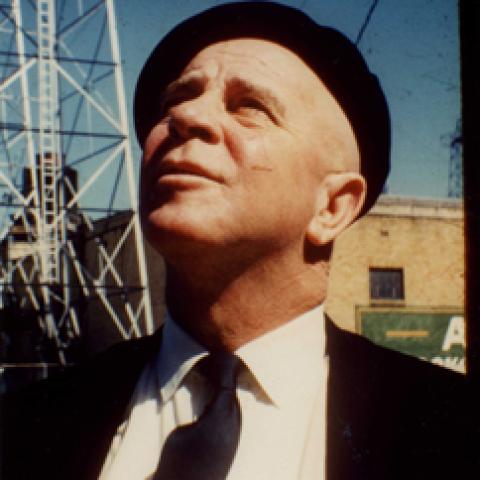Background
For the second time in as many years, I attended the East Texas Pipe Organ Festival held November 12–15, 2012, honoring the life and work of Roy Perry (1906–1978), featuring four organs built by Aeolian-Skinner that Perry designed and finished. The rationale for such an event is best summed up in Roy Perry’s own words in a brochure he wrote in 1952, shortly after the organs in First Presbyterian Church and St. Luke’s Methodist Church in Kilgore, and First Baptist Church in Longview were built:
A decade and a half ago the tonal designs of G. Donald Harrison were considered revolutionary, mostly because of the considerable publicity given a few of his organs built in the so-called Baroque style. At the present time, when tastes range all the way from extreme Romanticism . . . to the bleak austerities of the Baroque, his tonal ideas represent a temperate middle-of-the-road. The flexibility of his thinking is well demonstrated in the three organs considered in this booklet. None of these organs is extreme in any direction. They are alike only by way of family resemblance, but each in its way is a work of art. They provide a generous education in contemporary organ building as interpreted by this great artist, and are happily concentrated in a small geographical area.
It is clear from his own words that Roy considered G. Donald Harrison, and not himself, to be the designer of these organs. This raises the question: did Perry design these (or any other) A-S organs? Roy himself would have been the first to say it was GDH, whom he revered during their association. But it is also true that Roy had a lot of design control over the organs he sold for A-S and that GDH relied heavily on Perry’s knowledge in setting parameters. In the last fifteen years of A-S’s existence following Harrison’s death, Roy’s influence over “his” organs was even greater, sometimes even surreptitiously so!
However, the real signature that manifests itself in each of Roy Perry’s organs is the result of the finishing process in which he and the Williams family of technicians brought the factory-completed instruments to their full flower through installing and tonal finishing on site. (See Lorenz Maycher, “The Williams Family of New Orleans: Installing and Maintaining Aeolian-Skinner Organs,” The Diapason, May 2006.) This, multiplied over the span of his 20-plus-year career with A-S, puts a musical imprimatur on Roy’s organs that is hard to miss, although difficult to quantify by means of scientific measurement. Writing to Henry Willis III in 1955, Donald Harrison says that Roy
. . . has supervised, with the aid of Jack Williams [sometimes known as T. J.] and his son [Jim or J. C.], most of our important installations in Texas. He is an accomplished organist and has a wonderful ear. He is a top notch finisher and during my periodic visits to Texas I cannot remember a time when I have had to suggest that something might have been done a little differently. He just has that kind of organ sense.
Festival itinerary
Unlike AGO conventions and denominational conferences with which I personally have been involved, these festivals were my first experiences with a topic-specific conference, and the rewards for those who love these organs were enormous. All of the playing was memorable and the organs were in excellent condition, which made for an exhilarating week. [For an account of last year’s festival, readers are referred to Michael Fox’s review in the February 2012 issue of The Diapason.]
My complete participation was somewhat compromised by having to play services in Connecticut on Sunday morning, so I missed the pre-festival recital by Bradley Welch on Sunday evening in Longview. Further, part of my mission in attending was to provide transportation and note-holding for organ technician Stephen Emery. But I did attend all of the recitals on the four Aeolian-Skinner organs—the three in Kilgore and Longview, and one in Nacogdoches.
In addition to honoring the legacy of Roy Perry, this year the life and career of Alexander Boggs Ryan, noted teacher and performer from Longview, was commemorated in the Wednesday afternoon and evening sessions in Longview when the program departed from its A-S-centric (and even its organ-centric) scheme in an organ recital and a program of harpsichord music in Trinity Episcopal Church, the Ryan family church and organ. There was also a display of memorabilia on the lives of Perry and Ryan at the Gregg County Historical Museum.
Just as no discussion of these organs in their earlier generation would be complete without mention of the Williams family of organ technicians from New Orleans who installed and maintained them, so the work of Steve Emery was central to the success of this festival. For a week prior to the festival itself, and throughout the week of events, Steve gave these four organs the type of careful, knowledgeable, sympathetic attention that has earned him his reputation as an expert on the maintenance and restoration of these types of organs.
This circuit-rider approach to organ maintenance is not unlike what took place in the years following these organs’ initial installations and on other A-S installations throughout the region: the Williamses—T. J. and Sally, Jim and Nora, or some combination—would arrive on site, check into a motel and stay for a week or ten days once a year at the most! to do a thorough tuning and some planned repairs. Between these annual visits Roy Perry, assisted by locals, would tune and make minor repairs.
Monday
Before the festival officially opened, there was an opportunity in the afternoon to gather in St. Luke’s United Methodist Church in Kilgore for a demonstration of the organ and for some reminiscences and conversation with Charles Callahan and Larry Palmer on composers they had known and with whom they had worked.
Larry offered remembrances of his several commissions from and first performances of the works of Gerald Near, and Charlie told of his encounters with Leo Sowerby, David McK. Williams, and Thomas Matthews. Of particular interest, however, were his remembrances of visiting with Alexander Schreiner, pupil of Widor and Vierne, whom we know primarily as the organist of the Mormon Tabernacle immediately prior to and following the installation of A-S’s legendary five-manual organ. But Schreiner’s Ph.D. degree was in composition and he composed a lot of music, most of which is unknown.
The opening recital of the festival was given by Thomas Murray at the First Presbyterian Church in Kilgore on Monday evening and was the second annual recital honoring James Lynn Culp, organist emeritus of the church. At the mid-point in the evening a plaque was shown honoring Culp’s thirty years of service to the church, which will be placed in the chancel along with those to Roy Perry and G. Donald Harrison.
Murray’s use of the organ was the most conservative of the week and the organ obliged completely and effectively in replicating a sound more typical of the house of Skinner in its pre-Harrison days, even in his hefty dose of Bach—the Concerto in C after Ernst, and the Passacaglia. The rest of the program, and particularly the Franck Grande pièce symphonique, was informed by a 19th-century aesthetic. In the scherzo of the Franck, in particular, Professor Murray’s solid and assured technique was put to good use.
Tuesday
The morning recital was again at First Presbyterian Church and could not have been in greater contrast to the use of the organ the previous evening. I had not heard Walt Strony previously, although I had known his name and—erroneously, as it turns out—had assumed he was strictly a theatre organist. What I quickly learned was that his approach, technique, and style defies description in typical academic terms; Strony seems completely at home in concert, theatre, and church settings. It must have been this type of all-commanding wizardry put to solid musical principles that led throngs to hear organists Edwin H. Lemare and Archer Gibson in the early 20th century.
He used the organ in all of its permutations and possibilities. The standard groupings of organ tone and registration were clearly evident, but the imaginative exploitative quest for color and drama was also always apparent, and tastefully so. Walt’s biography in the program booklet says that he has written a book on theatre organ registration, which has become a standard reference work for theatre organists. I wish he would write one for classical organists, too. We have a lot to learn from him, especially those who attempt effective transcriptions.
Walt’s program was an eclectic mix of original works for organ, transcriptions, paraphrases of classical standards, and some dazzling arrangements of his own. His hymn arrangements made me ache for the pre-praise-band days when the organ was still the instrument of choice in evangelical churches. I particularly liked his inclusion of an arrangement of a Fats Waller piece, reminding us that Waller was an organist and knew Dupré! His performance of Lemare’s transcription of the Liebestod easily stood its own with Virgil Fox’s recording at Wanamaker’s. The Carmen Fantasy and closing Kismet suite on music by Borodin were the organist’s counterpart to a standard 19th- and 20th-century piano virtuoso’s staple—the symphonic paraphrase. In this case Walt struck me as being the Horowitz of the organ! Richard Purvis’s music (Capriccio on the Notes of the Cuckoo, and Thanksgiving from Four Prayers in Tone) captured the essence of the Kilgore organ, which was easily the equal of its slightly older and larger cousin, Grace Cathedral, the organ for which it was conceived.
I was impressed most of all by the fact that Walt Strony seemed comfortable in stepping aside and letting the organ take center stage in its own right. He did not try to mold it into his preconceived notion, or filter it through any established aesthetic. He didn’t attempt to make it sound like a theatre organ, or a so-called symphonic organ, or a classic organ, although elements of each were clearly present. It was simply the modern American organ playing music—and, in a word Roy Perry liked to use in describing this very organ, it was “deluxe!”
Tuesday afternoon the conference moved to Longview, about a ten-minute drive from Kilgore, and was devoted to a visit to Trinity Episcopal Church in Longview, the Ryan family church. Jeremy Bruns demonstrated the Ryan Family Organ built by Ross King, and Larry Palmer played a harpsichord recital featuring several works—modern works by Near, Martinu, Howells, and arrangements of Duke Ellington—which I was particularly sorry not to hear, but Steve Emery and I had our work cut out for us in tuning the large organ in the First Baptist Church. (See “Harpsichord News,” page 20.)
The history and aesthetic of the First Baptist Church in Longview is the stuff of legend. Its complete history is far too rich to adequately tell here. Suffice it to say that it could only have taken place due to three important and independent factors: the oil-rich location in East Texas, the population boom of the post-World War II era, and the visionary leadership of its pastor from 1945–1971, the Rev. Dr. W. Morris Ford.
Unlike some so-called “high” ecumenical Baptist churches in the South with impressive music programs and facilities to match—such as Myers Park in Charlotte, or River Road in Richmond (or even Riverside in New York)—First Baptist in Longview was always more or less a typical Southern Baptist church.
Dr. Ford was a cultured man with an earned doctorate, a love of music, and a fine singing and speaking voice. He sang both as soloist and with the church choir, and it was he who infused the church and its services with an innate sense of classical dignity in all things, which was his authentic response to the calling of the Gospel. This he did without diminishing the essential tenets or manifestations of the Baptist tradition.
When it was decided to build a new church, the vision was big and bold. The local architect B. F. Crain, who trained at Harvard, and built several notable buildings in the area, was selected and the style of the new church was determined to be “Modern Gothic.” To be frank, there is little that is Gothic about it in the textbook sense, but the scale and towering spaciousness—even its domination of its local surroundings—is obviously inspired by the Gothic aesthetic stripped to its essential unadorned lines. It seats 1,700 and was designed with the organ’s success in mind from the beginning. Taken in this light, the 87-rank organ seems modest, at least on paper. But its tonal impact is comprehensive and monumental. Writing in the aforementioned booklet about the organ when it was new, Roy Perry says:
Although this organ leans toward the Classic style, it affords five pairs of strings, a Vox Humana, and percussions, not to mention the wonderful flutes and small reeds. It will do justice to any music, even the humblest; in grandeur it holds its own with the great organs of the world.
The organ seems to have suited the needs and vision of the church perfectly; it was appreciated as an asset to the community and was played by the great organists of the day. Virgil Fox inaugurated the organ and ultimately played there several times, and Catharine Crozier made two notable LP recordings on it, which were iconic in publicizing and documenting the organ when new.
In the ensuing years recitals and concerts took place with regularity in the yearly round of church services and activities, including a performance in 1962 of the Bach St. John Passion sung by the Robert Shaw Chorale, of which by this time Dr. Ford’s son, David, was a member. The church may not have styled itself as anything but a typical Southern Baptist church, but during Dr. Ford’s tenure as pastor there were many opportunities to be presented with world-class music, in nearly perfect acoustical surroundings, by well-known recitalists and ensembles.
Richard Elliott, organist of the Mormon Tabernacle, played the Alexander Boggs Ryan Memorial Concert at First Baptist Church on Tuesday evening. The recital featured several pieces from various eras and genres, which presented the organ to excellent effect. Ryan had played a recital at the church in 1959 that included three pieces sung by the Rev. Dr. Morris Ford. These three songs (The Heavens Are Telling, op. 48—Beethoven; Panis Angelicus—Franck; and Recessional—Reginald De Koven) were here sung by David Ford, and it was good to hear the organ in its role as accompanist, which was a significant part of the organ’s duty in the normal round of services.
Richard played the technically demanding program with the ease and confidence audiences are accustomed to from his weekly broadcasts. The concluding work was the familiar Vierne Carillon de Westminster, which was characterized by an intense rhythmic drive throughout, and the gradual building up of dynamic forces, which continued throughout the piece until the very end. Elliott obviously knew how to elicit the most drama out of the organ. Many an organist wouldn’t be able to resist pulling out all the stops too soon; here the various climaxes were gauged and measured, saving something for the final few bars. It reminded me of the old Columbia recording of Alexander Schreiner playing this work at the Tabernacle, and it wouldn’t surprise me if Richard had patterned his scheme on it.
Wednesday
The first event of the day was a delightful program by Charles Callahan at St. Luke’s United Methodist Church that consisted of lesser-known gems by Bach, Fiocco, Charles and Samuel Wesley—honoring our host denomination—Peace, Wolstenholme, and three of his own compositions. The program was carefully chosen to highlight the great variety and nuance of this remarkable organ, and were played with charm, elegance, and lyricism. I sat in the back of the full, completely carpeted church and the organ had remarkable presence in the room, which itself was completely devoid of reverberation. This is a testament to the success of the organbuilder’s art.
Before lunch we walked the few blocks to First Presbyterian Church for Ann Frohbieter’s well-chosen program, which, with the exception of Houston composer Michael Horvit’s The Red Sea, consisted of standard, well-known organ repertoire by Reger, Vivaldi-Bach, Ives, Barber, Vierne, and Liszt. But the playing was anything but standard! Each piece was thrillingly played with an obvious affinity and understanding of the inherent resources and beauty of the organ. To me it was the perfect foil to Strony’s program the previous morning, showing the same thrilling approach to the organ via the repertoire. The Red Sea is a programmatic work of eleven sections that depicts the biblical drama of the escape and deliverance of the Israelites from the Egyptians through the Red Sea.
After lunch we walked back to St. Luke’s for a recital by Christopher Houlihan. The program was heroic for the small organ and room, but consistently well played from memory. Having heard the Bach Passacaglia on Monday evening, it was interesting to hear it again on this organ. Christopher’s interpretation sounded more at home in this setting. Houlihan has made a specialty of the Vierne symphonies, playing all six in marathon sessions around the country. Here he planned three movements (including the Final) from the Sixth, but after practicing at the organ, substituted three movements from the Second, which was a wise move.
I particularly liked the Bach trio sonata (C major) and his transcription of the slow movement of Debussy’s opus 10 string quartet. Each seemed to capture the chamber-music aspect of the music, which ideally suited this organ and this room. Christopher is certain to have a bright career ahead of him, and it was good to have someone from the younger generation on the festival roster. Incidentally, there were a good number of young people at the festival for individual events, and Joby Bell’s entire studio from Appalachian State University in North Carolina attended the entire week.
Wednesday evening was movie night at First Presbyterian Church as Brett Valliant accompanied the silent classic “The Phantom of the Opera.” Brett’s accompaniment was lyrical and lush and may have been inspired by the theatre organists of the past, but this, like Walt Strony’s program Tuesday morning, was simply the Kilgore organ rising to yet another musical task with satisfying musical results.
Thursday
Thursday morning the festival moved to Nacogdoches, where the smallest of the four A-S organs—located in the First Baptist Church—was featured. The worship space here is slightly larger than St. Luke’s in Kilgore and the factors involving the acoustics are much more favorable. The organ is a model of careful voicing, scaling, and finishing, is ideally suited to its surroundings, and is entirely satisfying on its own, in spite of its small size.
The program began with Scott Davis leading the audience in singing a hymn, with his improvised introduction, an interlude, and concluding stanza. Scott also concluded the program with an extended multi-movement improvisation in the style of his late teacher Gerre Hancock. These—the hymn singing and improvising—were the only nods during the week to the liturgical effectiveness these organs also possess.
The centerpiece of the program was another of Charlie Callahan’s signature programs of interesting, lesser-known works, which were carefully selected and performed to present the organ in its most favorable light—works by Clarence Dickinson, Nathaniel Dett, Joseph Clokey, and Richard Purvis’s Melody in Mauve, a harmonically rich and evocative gem. Charlie also played two recent compositions of his own: Alleluia (an energetic miniature, similar in feel to his more virtuosic Fanfares and Riffs) and Festival Voluntary on “St. Anne” for Horn and Organ, which received its first performance.
Charlie also spoke at some length about Roy Perry and the Williams family, and some of the other Aeolian-Skinner personalities he has known over the years growing up in Boston, particularly Arthur Birchall, for whom as a young man he held notes on tuning and finishing jobs. This was a valuable spoken addition to the otherwise instrumental nature of the week’s events.
Back to Kilgore for the afternoon recital by Christopher Jennings for what was anticipated as a highlight of the week: the complete performance of Clarence Dickinson’s Storm King Symphony at First Presbyterian. We know that Dickinson played individual movements from among the five, but there is no documentation of his (or anyone else’s) ever playing the entire work, and this was one of several times this season when Christopher has played it in its entirety. The program notes told us that the symphony “reflects impressions made on the composer by the varying moods of the stately Storm King mountain, which stands guard over the Highlands of the Hudson” near Dickinson’s home.
It is a pity that in most circles Dickinson’s compositions aren’t taken very seriously today. He wrote so many small works and carol arrangements that are so accessible that the larger forms, which require significant technical prowess, are basically unknown. Taken as a whole, the entire symphony could easily supplant the effect and aura of either the Reubke Sonata or Liszt Ad nos on a recital program.
Christopher’s use of the organ was informed by the early 20th-century organs that Dickinson would have known, but in a commanding and vivid way that did not sound retrospective. The natural power and expressiveness of the organ was entirely satisfying and there was not the impression that he was under-using the organ, even though he elected to leave out most of the upperwork. On occasion he used the famous Trompette-en-Chamade in chorus, Bombarde-wise, and it was very effective. The sound is not as ferocious as it looks, at least out in the church. In fact, it is one of the standard A-S Trompette Harmonique designs mounted horizontally, on reasonable wind pressure, which can in fact function as a chorus reed capping the full ensemble when called upon to do so.
I regretted that I could not attend the second half of the program, consisting of works by New York composers Alec Wyton, Calvin Hampton, and Gerre Hancock, as Steve Emery and I had to get over to Longview to touch up the tuning.
Ken Cowan played the concluding recital at First Baptist Church. In advance publicity on its Facebook page, festival director Lorenz Maycher wrote: “On the questionnaire, where his manager asked what kind of program we’d like, I put HEAVY DUTY. That’s exactly what we got. I love it when that happens!” There’s really not a lot that I can add to that. It was a huge program, played from memory, characterized by effortless technique in the service of the music, and impeccable use of the organ’s vast resources. It was epic and (sorry Virgil Fox) I don’t recall a better organ recital in my life.
When the Kilgore organ was new, one of the first players to present a recital on it was William Watkins, then not 30 years old. He had just won the Young Artist Award of the National Federation of Music Clubs, at the time the most prestigious competition to which any young musician could aspire; it was open to all instrumentalists. Watkins was the first organist to win it, and Roy Perry wisely brought him to play the new organ to a full church. The review in the Kilgore News Herald of February 17, 1950, which Watkins used in his publicity for many years, was written by Roy Perry himself, concluding “This boy is one of the great interpretive artists of the century.” The same can truthfully be said of Ken Cowan in this century. ν
All recent photography is by Bill Leazer and Paul Marchesano.






